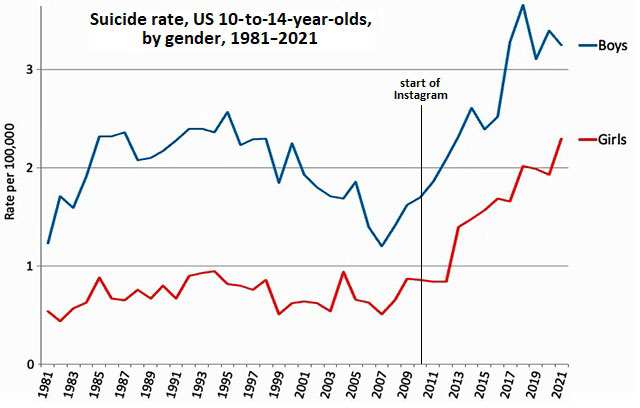|
In this issue PUBLIC DEFENDER: You can stop the avalanche of teen suicides due to social media Additional articles in the PLUS issue WINDOWS 11: How to manage Microsoft Store apps APPLE: Mac mini setup — KVM update PATCH WATCH: To reboot, or not to reboot
PUBLIC DEFENDER You can stop the avalanche of teen suicides due to social media
By Brian Livingston • Comment about this article The world is suffering from an explosion of teenage suicides and self-harm that are directly caused by the depression and suicidal impulses that young people develop through social-media use, according to medical experts. I called attention to these ghastly statistics in my July 8, 2024, column. Suicide rates among children as young at 10 have doubled or tripled since smartphones became glued to teenagers’ hands and social media such as Instagram became kids’ primary method of relating to the world. Finally, a respected psychologist — a professor of leadership at New York University’s Stern School of Business — has published a blueprint to end the bloodshed and bring children back into a healthy relationship with their electronic devices and each other.
How does a little kid of 10 — who may have only recently lost interest in playing with LEGO blocks or Barbie dolls — actually pull off an act as momentous as a suicide? Among 10-to-14-year-olds in the US, the most common methods of suicide are hanging/asphyxiation, firearms, and poisoning, according to a March 2024 study published in the JAMA Network by 11 medical experts. We can’t eliminate rope, handguns, and codeine from every household. So we’d better pay heed to the experts who’ve given us a call to action: Stop the role of social media in today’s wave of suicides and self-harm. Countries around the world restrict teens from dangerous activities
It’s been widely recognized for centuries that young people only gradually develop the maturity to handle risky situations. In the United States, the following activities are prohibited to children until they reach an age that is prescribed by law.
(These restrictions may vary by locality. For instance, the age of consent is 18 years old in 12 US states, 17 years old in seven states, and 16 years old in 31 states.) For complete coverage of multiple states and countries, see Wikipedia’s List of age restrictions. Why do I itemize the above age limits? Because almost every nation places guardrails on minors. For example, you may not think of “voting” as a dangerous behavior for teens. But virtually every democracy worldwide restricts voting rights until a young person is considered “mature enough” to make responsible decisions (18 in the US). Before I myself turned 18, I chafed at my state’s age restrictions on driving, drinking, and the like. I’m sure most teens have felt the same way since time immemorial. But country after country — based on years of experience — has decided that children of certain ages are best kept away from particular activities. The question before us is whether today’s social media are dangerous enough that age restrictions are in the best interests of us all. Social-media use is an addictive drug, according to psychologists
What policies do countries need in order to cut the depression and self-destructiveness that social-media use causes in tweens, teens, and even some young adults? Jonathan Haidt, the aforementioned psychologist and NYU professor, provides the answer in a new book: The Anxious Generation: How the Great Rewiring of Childhood is Causing an Epidemic of Mental Illness. Haidt and other psychologists blame the spike of teen self-harm and suicide on the 2007 introduction of the smartphone — with its large screen and front-facing camera for selfies — and the 2010 launch of Instagram and other social media. By 2012 or so, both technologies had spread like wildfire into a majority of homes in the US and many other parts of the world. The author cites shocking statistics on the increasing prevalence of harm to young people between 2010 and 2020. (His stats cover only the US, but other countries are experiencing similar upsurges). For example:
In his book, Haidt specifies four policies that parents, educators, and governments should immediately adopt:
Seeing the above four policies, you might say, “Brian, that sounds fine, but those things will never happen. The social-media companies are simply too strong, and young people are too addicted to their devices.” Actually, many of the above steps are already being taken, and social-media companies may not be able to prevent them from succeeding:
You may not have heard about COPPA’s legal requirements. That may be because the protections are enforced poorly, if at all. Haidt points out that by the time American kids turn 13, 40% of them have already created their own Instagram accounts, despite the law. Social-media use is causing real harm to real people
It’s easy to think that the above statistics are just numbers, that the problem is happening “to someone else.” But the problem is all around us and in our own backyards. Beyond the numbers are impressionable young people who experience crushing loneliness and despair from the onslaught of negative messages they receive every day from social media. One tragic example is the case of Aubreigh Wyatt, a 13-year-old girl who took her own life on Labor Day 2023. Other girls at her school engaged in “some pretty horrific harassment and bullying,” according to a Biloxi, Mississippi, Sun Herald news article.
In the aftermath of the terrible loss, the Wyatt family became embroiled in a series of lawsuits to determine liability for the psychological pressures that Aubreigh found unbearable. Her mother had to establish a GoFundMe page to raise enough donations to handle all the bills. With horrors such as these befalling our communities, we need to think long and hard about steps we can take to eliminate the influences that create these suicidal urges. Consider this thought experiment: Is social-media use more dangerous for teens than tobacco or alcohol? I’ve never heard of teenagers hanging themselves just because they happened to smoke a cigarette or drink a beer. Nevertheless, the US and some other countries absolutely prohibit children from consuming these products until reaching the age of 21. By contrast, social-media use is sending thousands of young people every year to a hospital — or to a grave. Since the electronic media have proved to be responsible for a terrible toll of self-harm and death, shouldn’t social media be limited to those over 21, just as the use of tobacco and alcohol require a person to be an actual adult? As the Beatles sang, “You may say I’m a dreamer, but I’m not the only one.” Unless we collectively take drastic action to rein in social media, we’ll be reading about — and perhaps attending — a lot more teenage funerals. Important: If you or someone you know is considering suicide or self-harm, immediately call 988 in the United States. In case of imminent danger, call 911. For the phone numbers of suicide-prevention hotlines in other countries, see Belle Health’s listing page.
The PUBLIC DEFENDER column is Brian Livingston’s campaign to give you consumer protection from tech. If it’s irritating you, and it has an “on” switch, he’ll take the case! Brian is a successful dot-com entrepreneur, author or co-author of 11 Windows Secrets books, and author of the fintech book Muscular Portfolios.
The AskWoody Newsletters are published by AskWoody Tech LLC, Fresno, CA USA.
Your subscription:
Microsoft and Windows are registered trademarks of Microsoft Corporation. AskWoody, AskWoody.com, Windows Secrets Newsletter, WindowsSecrets.com, WinFind, Windows Gizmos, Security Baseline, Perimeter Scan, Wacky Web Week, the Windows Secrets Logo Design (W, S or road, and Star), and the slogan Everything Microsoft Forgot to Mention all are trademarks and service marks of AskWoody Tech LLC. All other marks are the trademarks or service marks of their respective owners. Copyright ©2025 AskWoody Tech LLC. All rights reserved. |
||||||||||||||||||||||||




















